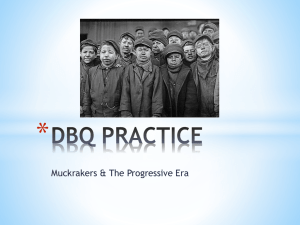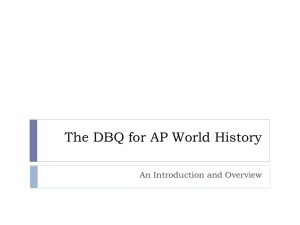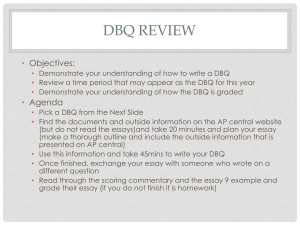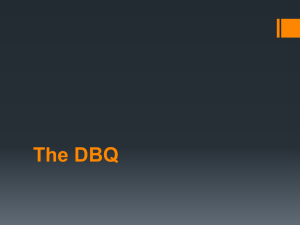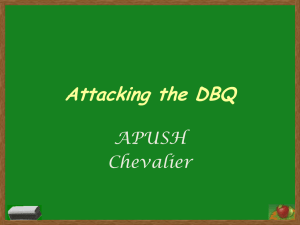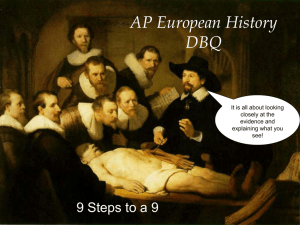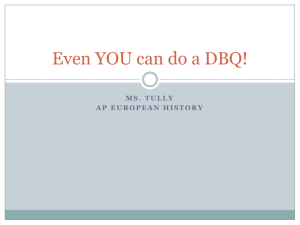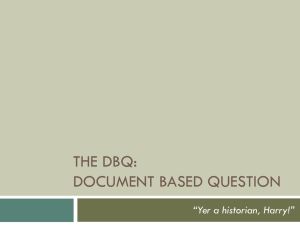The DBQ - Ms. Sheets` AP World History Class
advertisement
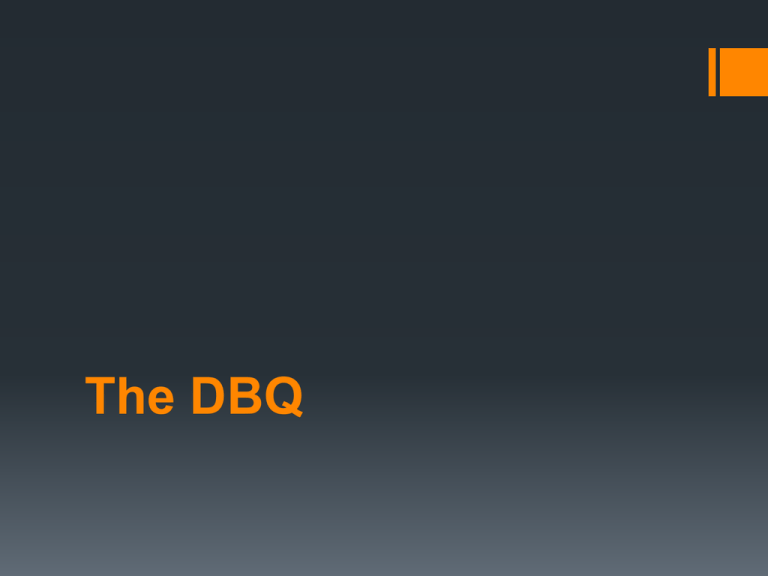
The DBQ About the DBQ • Primary purpose of DBQ is not to test students’ prior knowledge of subject matter. Rather, it evaluates their ability to formulate and support an answer from documentary evidence. • There is no single “correct” answer; various approaches and responses are possible. • Pretend you are a historian. You have already done all of your research (as evidenced by the documents), and you are now writing a paper where you must cite your evidence. How to DBQ How to DBQ 1) Read the Prompt A. Find and underline the key phrase • You will use the key phrase throughout your essay B. Determine what is the prompt asking DBQs: Find the Key Phrase 2002-2014 2002 Using the documents, compare and contrast the attitudes of Christianity and Islam toward merchants and trade from the religions’ origins until about 1500. Are there indications of change over time in either case, or both? What kinds of additional documents would you need to assess the consequences of these attitudes on merchant activities? There will never be a DBQ like this again! This was not only a DBQ, but also a CC and CCOT essay. This DBQ has the lowest average score ever on any DBQ. 2003 Using the documents, analyze the main features, including causes and consequences, of the system of indentured servitude that developed as part of global economic changes during the nineteenth and into the twentieth centuries. What additional kind of documents would help assess the historical significance of indentured servitude in this period? 2003 Using the documents, analyze the main features, including causes and consequences, of the system of indentured servitude that developed as part of global economic changes during the nineteenth and into the twentieth centuries. What additional kind of documents would help assess the historical significance of indentured servitude in this period? 2004 Based on the following documents, analyze the responses to the spread of Buddhism in China. What additional kind of document(s) would you need to evaluate the extent of Buddhism appeal in China? 2004 Based on the following documents, analyze the responses to the spread of Buddhism in China. What additional kind of document(s) would you need to evaluate the extent of Buddhism appeal in China? 2005 Analyze the issue that twentiethcentury Muslim leaders in South Asia and North Africa confronted in defining their nationalism. What additional kind of documents would be most helpful in furthering your analysis? 2005 Analyze the issue that twentiethcentury Muslim leaders in South Asia and North Africa confronted in defining their nationalism. What additional kind of documents would be most helpful in furthering your analysis? 2006 Using the documents, analyze the social and economic effects of the global flow of silver from the midsixteenth century to the early eighteenth century. Explain how another type of document would help you analyze the effects of the flow of silver bullion in this period. 2006 Using the documents, analyze the social and economic effects of the global flow of silver from the midsixteenth century to the early eighteenth century. Explain how another type of document would help you analyze the effects of the flow of silver bullion in this period. 2007 Using the documents, analyze Han and Roman attitudes toward technology. Identify an additional type of document and explain briefly how it would help our analysis. 2007 Using the documents, analyze Han and Roman attitudes toward technology. Identify an additional type of document and explain briefly how it would help our analysis. 2008 Based on the following documents, analyze factors that shaped the modern Olympic movement from 1892 to 2002. Identify and explain what additional type of documents or sources would help you assess these factors. 2008 Based on the following documents, analyze factors that shaped the modern Olympic movement from 1892 to 2002. Identify and explain what additional type of documents or sources would help you assess these factors. 2009 Using the documents, analyze African actions and reactions in response to the European Scramble for Africa. Identify an additional type of document and explain how it would help in assessing African actions and reactions 2009 Using the documents, analyze African actions and reactions in response to the European Scramble for Africa. Identify an additional type of document and explain how it would help in assessing African actions and reactions 2010 Using the following documents, analyze similarities and differences in the mechanization of the cotton industry in Japan and India in the period from the 1880s to the 1930s. Identify an additional type of document and explain how it would help your analysis of the mechanization of the cotton industry. 2010 Using the following documents, analyze similarities and differences in the mechanization of the cotton industry in Japan and India in the period from the 1880s to the 1930s. Identify an additional type of document and explain how it would help your analysis of the mechanization of the cotton industry. 2011 Using the following documents, analyze the causes and consequences of the Green Revolution in the period from 1945 to the present. Identify one additional type of document and explain how it would help your analysis of the Green Revolution. 2011 Using the following documents, analyze the causes and consequences of the Green Revolution in the period from 1945 to the present. Identify one additional type of document and explain how it would help your analysis of the Green Revolution. 2012 Using the following documents, analyze the relationship between cricket and politics in South Asia from 1880 to 2005. Identify an additional type of document and explain how it would help your analysis. 2012 Using the following documents, analyze the relationship between cricket and politics in South Asia from 1880 to 2005. Identify an additional type of document and explain how it would help your analysis. 2013 Analyze connections between regional issues and European struggles for global power in the mideighteenth century. Identify an additional type of document and explain how it would help your analysis of these connections. 2013 Analyze connections between regional issues and European struggles for global power in the mideighteenth century. Identify an additional type of document and explain how it would help your analysis of these connections. 2014 Using the following documents, analyze the relationship between Chinese peasants and the Chinese Communist Party between circa 1925 and circa 1950. Identify one additional type of document and explain how it would help you assess the relationship between the Chinese peasants and the Chinese Communist Party. 2014 Using the following documents, analyze the relationship between Chinese peasants and the Chinese Communist Party between circa 1925 and circa 1950. Identify one additional type of document and explain how it would help you assess the relationship between the Chinese peasants and the Chinese Communist Party. How to DBQ 2) Read and analyze the documents • Pay attention to the attribution! Note the author, time, and place. • Who is the Speaker? Occasion? Audience? Purpose? Subject? Tone? • Categorization (Kind? SPICE?) • Is POV Statement possible? • Is Additional POV possible? How to DBQ 3) Group the Documents • MUST have AT LEAST 3 groups/paragraphs • A group must include more than one document. • Any document can be used twice (or more), but it MUST be used at least once. • The documents are chosen because they have similarities with one another; you have to find those! How to DBQ 4) Write your thesis • Provide an answer to the prompt, but not using “the phrase” • Provide groups in thesis • These will be your paragraphs • Provide Place / Time (exactly as stated in DBQ prompt if provided) • Must be written in a single sentence (straightforward, state it quickly, and move on) How to DBQ 5) Write 1. Thesis Statement as Introduction 2. Body Paragraph (x3) - Topic Sentence (provide group; use phrase) - Doc 1 (example) - Concrete and Specific Details - Commentary / Connection to topic or thesis - POV Statement (if applicable) - Analysis (Why is this with the others) - Additional Document (if applicable) - Concluding Statement How to DBQ 6) Check your work • Go through the rubric to make sure you have everything you need. • Did you use every document? • Is your thesis clear without being a simple restatement of the prompt? Summary of Documents • Documents are chosen on the basis of both the information they convey about the topic and the perspective that they offer. • Documents should be used to substantiate and illustrate points made in the essay. • Students may group documents chronologically, culturally, or thematically, to demonstrate their ability to analyze sources, but they are not expected to have particular knowledge of every document’s author or topic or to include knowledge outside of the documents in order to receive the highest score. Questions to Ask About the Documents • What is the document saying? • Is the document similar or different to others in terms of content? • Who is speaking? (Attribution) • Why is this person significant? • What is the speaker’s POV? • Is this speaker/source reliable or accurate? • What is the author’s tone? 2008 DBQ Marking it up Summary of Documents Document #1: • Founder of Modern Olympics • Share athletes around the globe • Process will promote peace • “utopia,” free trade Summary of Documents Document #2: • 2% women participation (attribution) • Photograph • Empty stands • Long skirt: still must adhere to cultural standards Summary of Documents Document #3: • skis, cheating • Idea that Nazism > democracy • More than just a skiing competition; political competition too Summary of Documents Document #4: • Competed in the 1952 games • Soviets’ enemies, Cold War • Russians vs. Americans • “Got to beat ‘em” Summary of Documents Document #5: • “Defeated enemy syndrome” • World trade power • “Magic of the Olympics,” national crusades • Saving economic power of Olympics Summary of Documents Document #6: • USSR seen as “beacon of peace, democracy” • Propaganda, Soviet achievements • POV? Summary of Documents Document #7: • Corporations as top sponsors • Korean companies not among top sponsors • “failed to avail itself of an opportunity” • “stand to make a lot of gold” Summary of Documents Document #8: • 29% female participation (attribution) • Women representation • “Running in shorts” • “psychologically, they don’t think so” Summary of Documents Document #9: • Millions of US dollars fees paid to Olympic Committee for broadcasting rights • increase • Not US Government spending (misleading) Summary of Documents Document #10: • 2000 field hockey team • Pakistan’s team’s performance “tarnished” national pride • Discusses partition of India, archrivals • 2nd place 1956, Gold in 1960 How to Cite Documents in the DBQ • Winston Churchill, in a letter to Franklin D. Roosevelt, argued that . . . (Doc 7). • Tokugawa Ieyasu felt that . . . (Doc 1). • The graph reveals an increase in cotton production after the introduction of machines (Doc 4). • DO NOT begin with “In Document 8 . . . “ Understanding vs. Using for Evidence Christopher Columbus states that he was “shocked and appalled” by the nakedness of the indigenous people (Doc 4). This statement reveals that you understand Document 4. Though this statement is important for letting the reader know you understood what you have read, you are doing nothing but retelling what you have just read; this statement does not count as evidence. Understanding vs. Using for Evidence Christopher Columbus states that he was “shocked and appalled” by the nakedness of the indigenous people (Doc 4). Thus, we see Christopher Columbus imposing his European cultural ideas regarding clothing and decorum upon a group of people who are foreign to those ideas. Clearly, pre-conceived cultural notions were at play during some of the first meetings of the Old and New World. These statement reveals that you both understand Document 4 and are using this document for evidence. The first sentence is a mere regurgitation of what Document 4 states; though this is not an eloquent way of indicating to the reader you understand Document 4, it does the job. The next statement is YOUR INTERPRETATION of the document. You are pulling out what is significant about the document and sharing it with the reader. Writing the Thesis Three– Step Process 1. Restate prompt 2. Define groups 3. Develop time/relationships Thesis 2012: Analyze the relationship between cricket and politics in South Asia from 1880-2005. 1) Restatement: The relationship between cricket and politics in South Asia from 1880-2005 revolved around political control, cultural traditions, and nationalism. This is considered a simple restatement of the prompt and would not receive a point on the AP. 2) Work on groups: 1. 2. 3. 1. Political control British want this over South Asians Cultural traditions eliminate barriers Nationalism define new national identity of India under Britain, and then India after independence Who is using cricket? Why? The British use it originally over the Indians Ultimately, the Indians adopt it for themselves 3) Develop relationships and time periods in final thesis: The British by 1880 had used cricket as a way to gain political control of South Asia, yet the sport was adopted by South Asians in defining their nationalism and in eliminating cultural barriers to unification by 2005. Example 2007: Analyze Han and Roman attitudes toward technology 1) Restatement 2) Work on Groups 3) Develop relationships 1) Restatement: Han and Roman attitudes toward technology were favorable because technology strengthened the empires, helped to bring the empire together, and made daily life easier. 2) Work on groups: 1) Strengthening the empire this can stay the same 2) Bringing the empire together unification 3) Making daily life easier simplification 3) Develop relationships/time period in final thesis: Throughout their existence, the Han Dynasty and Roman Empire utilized technology to strengthen the empire/dynasty, unify the various corners of the empire/dynasty, and simplify daily life, which resulted in the belief among these civilizations that technology was effective and worthwhile. Point of View Statement • Identify who is speaking and what their tone is • Explain what they believe • Why do they believe that? Is it tied it to their group/classification? Remember position informs opinion. Think about the dress code . . . What would you think about that if you were the principal, or maybe a student? Does WHO you are change HOW you think about that issue? • Write your POV statement in one of the following formats: • As a _______, it is understandable that ________________. • As a _______, one can see why _____ felt that __________. • As a _______, one can assume that _______ felt that _____. Point of View Statement 1) Authorial Point of View - Most of the time, POV will focus on demonstrating that the gender, class, religion, occupation, nationality, political position, race or ethnic identity of the author would influence/affect his opinions. - Why did the author write what he/she had? Example: As a Japanese peasant overworked, exhausted and often ill in the cotton factory, Aika Shunsuke felt resentful towards the wealthy factory managers since she saw herself and her family as exploited by these men. Additional Document • Discuss a document that you would like to see and WHY - At least 1 per paragraph - Students only get credit if they explain WHY • The additional document should be something that illustrates a perspective, point of view, or issue that is not represented in the document • Doesn’t have to be a document that DOES exist . . . has to be one that COULD exist. • An additional document that would _____(use the phrase)_______ would be _______. This would reveal/show _________. Practice Additional Sources: Document 1 An Olympic athlete competing in the 1892 games; did this person view the Olympics in the way that it was envisioned by de Coubertin? An additional document that would help me learn more about factors that shaped the modern Olympic movement would be an article detailing the perspective of an Olympic athlete who competed in the 1892 games. This document could show us if this athlete viewed the Olympics in the way that they were envisioned by de Coubertin, thus revealing if de Coubertin’s dreams of political utopia were shared by others. Practice Additional Sources: Document 8 A male Olympic competitor and peer of Boulmerka; what he feels about Boulmerka; did the Olympics achieve the gender equality they strove towards? An additional document that would help me learn more about factors that shaped the modern Olympic movement would be an article with the perspective of a male Olympic athlete who competed in the games with Boulmerka. This document could show us what this athlete felt about Boulmerka (and other women) competing, and would indicate whether or not the Olympics achieved the gender equality they were working towards. DBQ Rubric Handout 1) What does the AP require I do? 2) What must I do for this class? Wednesday, August 20th – 2008 DBQ due Write it at home and annotate the following parts: 1)Thesis – bold 2)Groups – underline 3)POV – italicize 4)Additional document - different font/size 5)DBQ documents – in text citation (doc 8)
